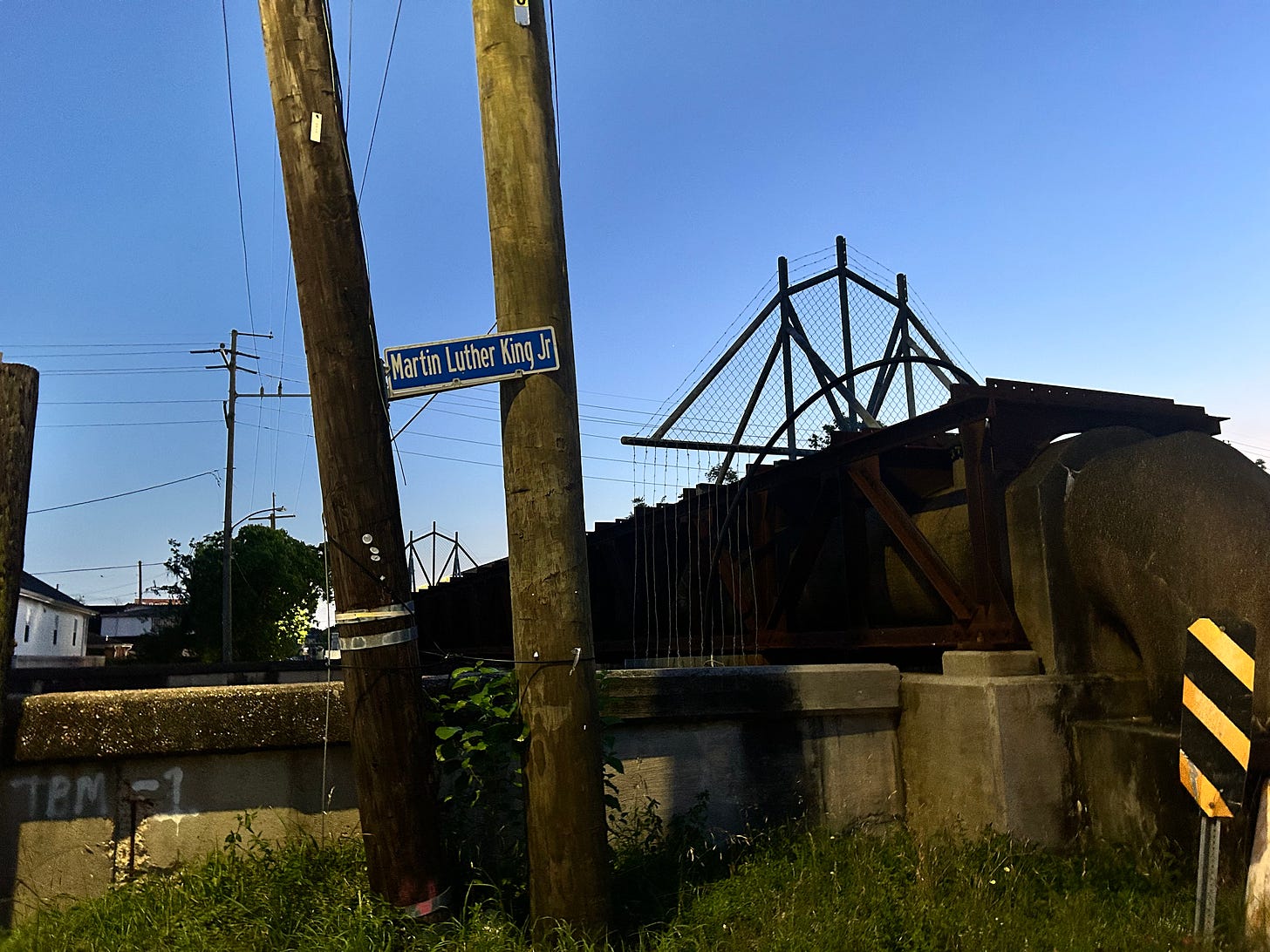Uncharacteristically, I am soliciting opinions today. Read to the bottom to learn more.
The moon is gibbous orange over the Melpomene Pumping Station, where Martin Luther King, Jr. Boulevard crosses South Broad, and the Washington-Palmetto Canal begins. It is quite romantic at the rivermost tip of Zion City. We are in zip code 70125. The pastors of this zip code's churches perform more marriages per capita than in an other New Orleans postal zone.
The canal is a ribbon of light cutting through a dimly-lit streetscape punctuated by porch lights. Silhouettes are smoking and nodding. Laughter punctuates the air. Shadowy figures flit between the darkened streets. Around the every-other street lights and the carbon-arc lamps over the canal, moths and termites flutter about and by.
High overhead, on top of the AT&T cellular transmission tower, the red beacon flashes slowly. Musicians use it to set their metronomes.
It is noticeably warmer around the tower the closer one gets to its address between Clio and Erato Streets. When traveling to this end of Gert Town, expect the temperature to be 1.6 degrees higher than the rest of New Orleans. Good things happen between Clio and Erato. That is why it is fenced in with barbed wire. No Trespassing.
A block away, on South White Street the narrow metal footbridge clangs with footsteps on its uptown stairs. A wraith in a yellow hoodie makes his way, stumble-wise, to the opposite side. Both sides are Martin Luther King, Jr. Boulevard. The canal forms the neutral ground. More on that later.
The wraith stops in the middle of the bridge, doubles over and coughs. He coughs for a long time, doubled over. It sounds like he is trying to talk to crows. He keeps coughing, "Cras! CRAS! Cras!" He is too old to be croupy.
When he makes his way to the canal wall, he falls down the stairs. It's a good thing the wall isn't tall. He picks himself up and stumbles down South White Street, headed toward Restaurant Depot, where the restaurants shop.
The Washington stretch of the Washington-Palmetto Canal is no nicer than the part that runs between the lanes of Palmetto Street. The part in Old Metairie is no nicer, either. The wet part of the canal, the deepest part that makes this more than a wide concrete ditch, is no more three feet wide. Nobody has a ruler when you need one.
If the canal part of the canal was filled in, two cars could pass each other. There is that much flat space on either side. With a yard-wide channel down the middle of the street, that's a no-go. No films have ever been shot in the canal, which is a shame. Not only is it romantic, it's dramatic. The walls slope from the bottom to sea level on either side.
The canal is not dramatically deep. If a professional acrobat stood on somebody's shoulders, he could see down South Dupre Street in either direction. If he did a backflip, in either direction, he would go over the wall and land in a pothole. Don't try this, yourself. This improbable stretch of Martin Luther King, Jr. Boulevard is poorly maintained. It is, essentially, two one-way dead ends. It is lightly trafficked.
The part of Martin Luther King, Jr. Boulevard between Melpomene and the pumping station is nice. After the pumping station, it is a lumpy track paved with mattresses over puddles that never drain. There is a nest of blue parakeets in one of the utility poles. The scenery is bittersweet.
If the acrobat did a backflip toward Lake Pontchartrain, he would land atop the noblest sewage pipe in the City of New Orleans. Stalwart and taciturn, this rusty behemoth has carried the effluvium from furthest Uptown, to the S&WB's East Bank Sewage Treatment Plant at 2800 Florida Avenue, 70117.
The pipe, which has a diameter of 42 inches, has been called 'Old Trusty' by generations of Zion Citizens as long back as anyone can remember. While Hollywood has never come calling to the Washington-Palmetto Canal, Hollygrove has. Music videos are regularly shot there. Little Wayne is from Hollygrove.
You just pronounced Hollygrove wrong. If you say Hollygrove like you're from Gert Town, I’ll spell Little Wayne the way it’s pronounced.
It is officially called Sewerage & Water Board New Orleans, or SWBNO. Its executive director is a well-intentioned fellow who is not originally from New Orleans. He and those who report directly to him are the only ones who say SWBNO. Everyone else writes it S&WB for short. Nobody from New Orleans has the resident expertise to run S&WB. That is why Ghassan Korban was hired.
S&WB operates 1600 miles of sewer pipes on both banks of the Mississippi River. It is a gravity collection system consisting of lateral and trunk sewers connected to 83 electrically operated pumping and lifting systems. 79 of these stations operate automatically, unmanned. That makes for less inputs for the system to process.
[I wrote this last night. It was going to go in a different direction (I know you have no idea what direction this is going in. Bear with me). I am not sure if I should keep this or just rework the whole thing.
Never has so much attention been lavished on a homely sewer pipe.
Should I keep this? Comments open to all today. Tell me what you think.]
Thank you in advance, -K.






Keep. S&WB is interesting on so many levels. Is sewerage a real word, for example.
I find your stories very interesting! Love learning about New Orleans and your travels around the city. Keep this article and Old Trusty.